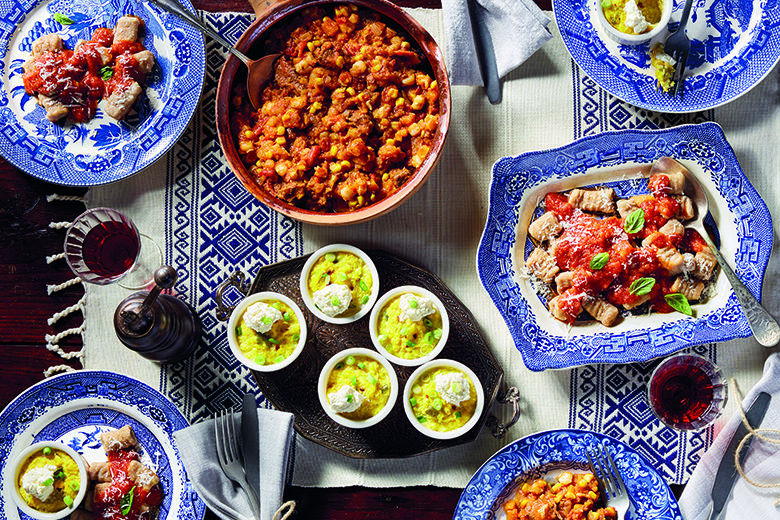
A moment with friends and family in Argentina automatically translates into a get-together meal. It’s the perfect moment to talk, share a laugh and strengthen relationships. Many Argentineans are Italian descendants and most of us grew up with nonnas (Italian grandmas) who taught us the love for real ingredients, the simplicity of homemade meals and the pleasure of eating together with no rush.
The most common friendship ritual involves mate (pronounced MAH-tay), a unique tea-like beverage from indigenous origin. Typically, hot water is poured over yerba mate leaves in a small pot-like container usually made from a carved, dried gourd. The infusion is sipped directly from the gourd with a bombilla, a metal straw with a strainer. Then, it’s filled up again and passed down to the next person, sharing the same gourd and straw. Hardly ever served at restaurants, it is a drink enjoyed with close ones at home or at work.
Culinary Roots and Traditional Dishes
Located in the southern part of South America, Argentina epitomizes diversity — a nation with impressive contrasts of landscapes, climates and culture, and a vibrant gastronomy full of history. Between 1870 and 1930, more than 7 million immigrants came from Europe (mainly from Italy and Spain) to work and live in Argentina. This helped shape Argentinean food culture with influences from Mediterranean immigrants and creoles (native inhabitants and Spanish colonials).
Argentina once had the highest beef consumption in the world (now second after Uruguay), but cost and health concerns led many Argentineans to replace beef with poultry, pork or meatless protein sources. Still, beef is central to Argentinean life and is prepared several days a week in dishes such as empanadas (stuffed pastries from Hispanic heritage), milanesas (breaded meat fillet, a variation of an Italian dish) or stews such as locro (native dish made of corn, pumpkin and meats). One of the most iconic dishes is asado (barbecued beef on an open flame) served with the classic chimichurri sauce.
The Italians brought pizza and pasta to the Argentinean table. On Sundays, some grandmas still make homemade tallarines (noodles), lasagna, cannelloni and ñoquis (gnocchi). In fact, there is a curious ritual about gnocchi: The 29th of every month is Gnocchi Day, when gnocchi are eaten for luck. One potential origin of this tradition is to honor Saint Pantaleon, canonized on a 29th, an Italian saint who lived a simple life and frequently ordered a modest plate of gnocchi to eat. A second story came about in the 1970s when, due to lack of cash by the end of the month (just before monthly pay day), housewives chose budget-friendly ingredients such as potatoes and flour to make gnocchi.
Eating Habits and Nutrition Challenges
Argentineans usually have four meals per day. Breakfast is a simple meal, with café con leche (coffee with milk), pastries or toasts with butter or sour cream, jams or the typical Argentinean dulce de leche (milk caramel). For awakening, some people prefer to drink mate, which contains a moderate amount of caffeine and antioxidants. Lunch is quite variable and may include meats, salads, sandwiches, tartas (quiches) or empanadas. Afternoon snack, known as merienda, is around tea time (5 p.m.) and is similar to breakfast. Dinner tends to be the biggest meal of the day, including meats, pasta and vegetables, and is served late, rarely before 8 p.m. or 9 p.m.
Healthier food choices, vegetarian options and organic produce are trending today in cities such as Buenos Aires. At the same time, the prevalence of obesity and chronic diseases has been growing mainly due to decreased physical activity and poor diets, particularly in low-income families. According to the latest Ministerio de Salud survey, four in 10 adults are overweight and two of them are obese, while fruit and vegetable consumption is only at 1.9 servings per person daily. Argentinean Dietary Guidelines recently were updated to promote healthier culturally acceptable diets and to guide the food industry, policies and programs.
Traditional Argentinean dishes can be made healthier without sacrificing their essence by making a few tweaks, such as choosing lean cuts of beef, including more plant-based ingredients and using small amounts of healthy fats for cooking. Either way, it’s essential to keep alive the tradition of cooking at home with simple, real ingredients and enjoying food with others, like our nonnas did.
See the Argentinian recipes that accompanied this story: Hearty Hominy Stew, Humita in a Pot and Gnocchi with Tomato Sauce.






